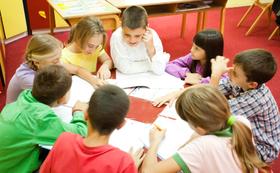Top Rankings
Robbinsdale Public School District ranks among the top 20% of public school district in Minnesota for:
Category
Attribute
Diversity
Most diverse schools (Top 1%)
Community Size
Largest student body (number of students) (Top 1%)
For the 2025-26 school year, there are 13 public high schools serving 3,720 students in Robbinsdale Public School District. This district's average high testing ranking is 3/10, which is in the bottom 50% of public high schools in Minnesota.
Public High Schools in Robbinsdale Public School District have an average math proficiency score of 19% (versus the Minnesota public high school average of 36%), and reading proficiency score of 45% (versus the 51% statewide average).
Public High School in Robbinsdale Public School District have a Graduation Rate of 82%, which is less than the Minnesota average of 83%.
The school with highest graduation rate is Robbinsdale Armstrong Senior High School, with 92% graduation rate. Read more about public school graduation rate statistics in Minnesota or national school graduation rate statistics.
Minority enrollment is 68% of the student body (majority Black), which is more than the Minnesota public high school average of 37% (majority Hispanic and Black).
Overview
This School District
This State (MN)
# Schools
30 Schools
1,171 Schools
# Students
10,735 Students
309,919 Students
# Teachers
692 Teachers
18,769 Teachers
Student-Teacher Ratio
16:1
16:1
Student By Grade
District Rank
Robbinsdale Public School District, which is ranked within the bottom 50% of all 520 school districts in Minnesota (based off of combined math and reading proficiency testing data) for the 2022-2023 school year.
The school district's graduation rate of 81% has increased from 80% over five school years.
Overall District Rank
#365 out of 525 school districts
(Bottom 50%)
(Bottom 50%)
Math Test Scores (% Proficient)
26%
46%
Reading/Language Arts Test Scores (% Proficient)
43%
51%
Science Test Scores (% Proficient)
32%
41%
Graduation Rate
81%
84%
Students by Ethnicity:
Diversity Score
0.75
0.57
% American Indian
1%
2%
% Asian
6%
7%
% Hispanic
18%
11%
% Black
30%
11%
% White
34%
63%
% Hawaiian
n/a
n/a
% Two or more races
11%
6%
All Ethnic Groups
District Revenue and Spending
The revenue/student of $20,898 is higher than the state median of $17,860. The school district revenue/student has grown by 8% over four school years.
The school district's spending/student of $19,880 is higher than the state median of $18,585. The school district spending/student has grown by 8% over four school years.
Total Revenue
$224 MM
$15,547 MM
Spending
$213 MM
$16,179 MM
Revenue / Student
$20,898
$17,860
Spending / Student
$19,880
$18,585
Best Robbinsdale Public School District Public High Schools (2025-26)
School
(Math and Reading Proficiency)
(Math and Reading Proficiency)
Location
Quick Facts
Rank: #11.
Robbinsdale Armstrong Senior High School
(Math: 29% | Reading: 53%)
Rank:
Rank:
5/
Bottom 50%10
10635 36th Ave N
Minneapolis, MN 55441
(763) 504-8801
Minneapolis, MN 55441
(763) 504-8801
Gr: 9-12 | 1,784 student Student-teacher ratio: 23:1 Minority enrollment: 54%
Rank: #22.
Highview Alc
Alternative School
(Math: ≤10% | Reading: <50% )
Rank:
Rank:
2/
Bottom 50%10
2400 Sandburg Ln
Minneapolis, MN 55427
(763) 504-8700
Minneapolis, MN 55427
(763) 504-8700
Gr: 9-12 | 224 students Student-teacher ratio: 17:1 Minority enrollment: 84%
Rank: #33.
Robbinsdale Cooper Senior High School
(Math: 8% | Reading: 37%)
Rank:
Rank:
2/
Bottom 50%10
8230 47th Ave N
Minneapolis, MN 55428
(763) 504-8500
Minneapolis, MN 55428
(763) 504-8500
Gr: 9-12 | 1,474 student Student-teacher ratio: 17:1 Minority enrollment: 83%
Rank: #44.
Robbinsdale Virtual Academy
(Math: ≤10% | Reading: 30-34%)
Rank:
Rank:
1/
Bottom 50%10
2400 Sandburg Ln
Minneapolis, MN 55427
(763) 504-8700
Minneapolis, MN 55427
(763) 504-8700
Gr: 6-12 | 186 students Student-teacher ratio: 17:1 Minority enrollment: 69%
Rank: n/an/a
Adult Academics
Alternative School
305 Willow Bend
Minneapolis, MN 55428
(763) 504-8301
Minneapolis, MN 55428
(763) 504-8301
Gr: 9-12
Rank: n/an/a
Armstrong Credit Recovery
Alternative School
10635 36th Ave N
Minneapolis, MN 55441
(763) 504-8800
Minneapolis, MN 55441
(763) 504-8800
Gr: 9-12
Rank: n/an/a
Cooper Credit Recovery
Alternative School
8230 47th Ave N
Minneapolis, MN 55428
(763) 504-8500
Minneapolis, MN 55428
(763) 504-8500
Gr: 9-12
Rank: n/an/a
Highview Independent Study
Alternative School
2400 Sandburg Ln
Minneapolis, MN 55427
(763) 504-8700
Minneapolis, MN 55427
(763) 504-8700
Gr: 9-12
Rank: n/an/a
Isd 281 Credit Recovery
Alternative School
10635 36th Ave. N
Minneapolis, MN 55427
(763) 504-8162
Minneapolis, MN 55427
(763) 504-8162
Gr: 6-12
Rank: n/an/a
Phoenix School
Alternative School
11505 36th Ave N
Minneapolis, MN 55427
(763) 504-8082
Minneapolis, MN 55427
(763) 504-8082
Gr: 7-12
Rank: n/an/a
Robbinsdale Shared Time Program
Special Education School
4148 Winnetka Ave N
Minneapolis, MN 55427
(763) 504-8082
Minneapolis, MN 55427
(763) 504-8082
Gr: K-12 | 6 students Minority enrollment: 34%
Rank: n/an/a
Robbinsdale Transition Center
Special Education School
305 Willow Bend
Minneapolis, MN 55428
(763) 504-8082
Minneapolis, MN 55428
(763) 504-8082
Gr: 12 | 46 students Student-teacher ratio: 9:1 Minority enrollment: 67%
Rank: n/an/a
Summer Credit Recovery
Alternative School
4148 Winnetka Ave N
Minneapolis, MN 55427
(763) 504-8162
Minneapolis, MN 55427
(763) 504-8162
Gr: 9-12
Recent Articles

School Vouchers: Updated Pros and Cons (2025 Review)
Comprehensive 2025 analysis of school vouchers, weighing benefits and challenges for families, funding, outcomes, and policy directions.

Benefits and Drawbacks of Homework in 2025
Explore updated 2025 insights on homework’s benefits, drawbacks, mental health impact, best practices, and policy trends in U.S. public schools.

Charter Schools vs Public Schools 2025: Key Differences & Trends
Explore updated 2025 insights comparing charter schools vs public schools, enrollment, academic outcomes, funding, and real-world examples for families and educators.





